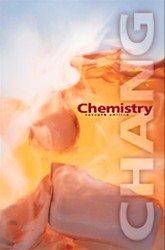|
 |  Chemistry, 7/e Raymond Chang,
Williams College
Gases
Internet ExercisesLos Alamos National Laboratory
(http://www.shef.ac.uk/chemistry/web-elements/main/index-nofr.html)
- Another popular periodic
table on the web, located at the Los Alamos National Laboratory, gives some
background information on each element. Go to http://www.shef.ac.uk/chemistry/web-elements/main/index-nofr.html,
look at the information given for argon, and then answer the following:
- At what
pressure is argon used in electric light bulbs and fluorescent tubes?
- Calculate the pressure
(in atm) exerted by 1.95 moles of the gas in a steel vessel occupying
a volume of 5.73 L at 58.6°C.
- A certain lightbulb
containing argon at the temperature and pressure given above is cooled
to 18°C at a constant volume. Calculate its final pressure in mm
of Hg.
|
 |  |  | NIST Webbook
( http://webbook.nist.gov/chemistry/)
- The NIST Webbook at
http://webbook.nist.gov/chemistry/
is a useful database that provides a search function to find out information
about compounds using only a name, formula, molecular weight, or other piece
of known information. Search for ammonia by using its formula, and then answer
the following:
- Calculate the density in g/L of NH3 at 752 mm Hg and 43°C.
- Calculate the root-mean-square speed of molecular nitrogen at 20°C.
|
 |  |  | http://wwwchem.csustan.edu/chem1002/gasevol.htm
(http://wwwchem.csustan.edu/chem1002/gasevol.htm)
- Some universities post their experiments on webpages. Fortunately, most of these pages provide a
bit of theory so that any student reading the material will understand the
relationship between the concepts and the actual lab. Study the experiment
given at http://wwwchem.csustan.edu/chem1002/gasevol.htm.
- How many moles of carbon dioxide will be produced if 5 grams of sodium bicarbonate are used?
- If a sample of the gas were heated in a flexible container, would the volume of its container increase or decrease?
- Suppose 500 mL of carbon dioxide were collected. If the pressure inside the flask is 2 atm and the volume of the container is increased at a constant temperature to 600 mL, what is the final pressure?
|
|
|



 2002 McGraw-Hill Higher Education
2002 McGraw-Hill Higher Education

 2002 McGraw-Hill Higher Education
2002 McGraw-Hill Higher Education